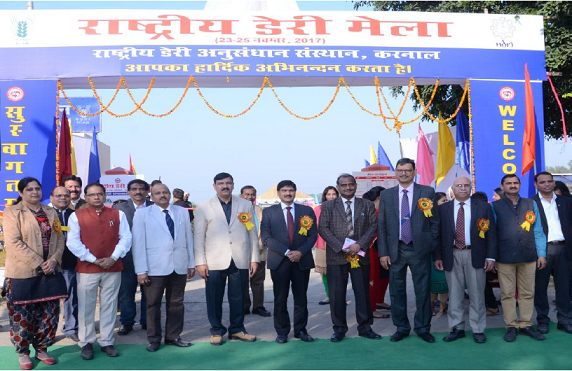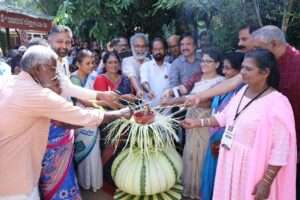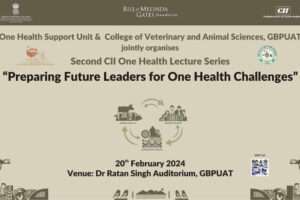 Mrs Misha Madhavan M and Ms Aswathy Chandrakumar, both Ph.D. scholars in the Dairy Extension Division, ICAR-NDRI, attended the National Dairy Mela organized at their institute and share their experiences here.
Mrs Misha Madhavan M and Ms Aswathy Chandrakumar, both Ph.D. scholars in the Dairy Extension Division, ICAR-NDRI, attended the National Dairy Mela organized at their institute and share their experiences here.
CONTEXT
The Indian dairy sector plays a crucial role in our country’s economy. Despite the prospects in this sector, technological advances in areas such as breeding, feeding, management and health care are yet to be fully adopted by farmers engaged in the dairy sector. While India aims to bring out the best for farmers, it is imperative to meet their growing information needs and boost dairying to its best. However, the findings of National Sample Survey Office (NSSO) clearly highlight the fact that 59 per cent of the farmers did not have any access to information on latest technological advances in agriculture.
This signifies the importance of organizing technology out scaling programmes like Farmer Fairs, Exhibitions, Kisan Sanghoshtis etc., which can act as platforms for facilitating dialog between scientists, farmers and other stakeholders involved in farming. Through such initiatives farmers can be better informed about proven technologies which could help boost their production. The ICAR-National Dairy Research Institute (ICAR-NDRI), Karnal, organized a three day National Dairy Mela from 23 to 25 November, 2017, to showcase the various technologies developed at NDRI and at other sister institutes located in and around Karnal. The mela attracted more than 2,500 visitors from different states like Uttar Pradesh, Haryana, Punjab, Delhi and Rajasthan.
PROGRAMME
Inaugural session 
The Mela was inaugurated by Shri Chhabilendra Roul, Additional secretary (DARE) and Secretary (ICAR) in the presence of Dr R R B Singh, Director, NDRI. During the Inaugural speech, he highlighted the need for bridging the gap between Research Institutes and farmers. On the backdrop of the stated objective of doubling the farmer’s income by 2022, this multi stakeholder interface assumes
considerable significance. He also gave emphasis on the importance of Farmer Producer Organizations (FPOs) and integrated farming, which helps to increase the farmer’s share in consumer rupees. The efforts of NDRI in hosting competitions and giving recognition to the farmer’s efforts were well appreciated by Shri Chhabilendra Roul. Dr R R B Singh in his speech, briefed the audience about the purpose of conducting the National Dairy Mela, annually. He also mentioned the activities of Business Planning and Development (BPD) unit of NDRI which has led to the formation of more than 200 dairy based enterprises by its trainees. He also stressed the activity of ration balancing by the animal nutrition division of NDRI, which has helped farmers to reduce the cost by 10-12 per cent.
Exhibition stalls
The 100 stalls at the Dairy Mela were a visual treat for the diverse visitors who ranged from students, farmers, academicians, researchers as well as entrepreneurs. All the stalls were well equipped to cater to the information needs of the visitors. Of the 100 stalls, 27 were government stalls and the remaining 73 were owned by private companies. The major attractions in the stalls are briefed in the following section.
NDRI stalls
Various divisions of NDRI had their own stalls in the National Dairy Mela showcasing their technologies and addressed the information needs of farmers. Posters, bulletins, models, stills, products, samples and videos were arranged for the visitors along with the demonstration of various technologies. Besides, information regarding the technologies were distributed to the visitors in the form of leaflets and pamphlets in the local language (Hindi). The
active participation of students and scientists of ICAR-NDRI in their divisional stalls, helped farmers and visitors clarify their queries. Entrepreneurs and aspiring entrepreneurs might have found this mela quite helpful as NDRI exhibited technologies which can be purchased to start their own ventures. The technologies included the strip based tests for the identification of adulterants like Detergent, Maltodextrin, Glucose, Urea etc., in milk; fortified dairy products; collection of different cultures for producing dairy products; rapid test for detection of e coli. in milk; etc.
The stall of Artificial Breeding Research Centre (ABRC) aroused curiosity among the visitors as they got to know more about semen straws and the artificial insemination technique. The KVK stall provided information on vermi composting and their staff shared their expertise on production of vermi compost. A Model developed by the students of the Dairy Extension Division, on Individualized Production, Community Processing and Marketing, was one of the major attractions in the Dairy Mela. A small village where integrated farming and various other good practices in agriculture and dairy production were practiced was shown at one side and the urban area from where the huge demand for high quality agri and dairy products comes from, was shown at the other end of the model. Then the model explained how to make a link via community processing and marketing units between the two, without any intermediaries so that farmers get maximum benefit from their products and consumer gets quality products. The use of digital media for marketing was also included in the model to connect with the consumers. The eye catching design of the model drew the attention of a huge number of visitors.
Private exhibition stalls
Most of the exhibition stalls were occupied by private companies, involved in the production of livestock feed and medicines, and manufacturing of dairy machineries. This revealed the growing relevance of private players in the sector. DeLaval, a part of the Tetra Laval group, actively participated in the mela by providing A-Z solutions to dairy farmers and they also exhibited their new milking machines, developed for small dairy units. Sexcel, another foreign based company with retail outlets in India, had set up a stall at the dairy mela and disseminated information regarding sexed semen technology. This technology proves to be more advantageous than artificial insemination as the former gives the farmer an option to produce either male or female offsprings depending on their core business. Another attraction among the private stalls was the hydroponic technology demonstrated by Ayurvet Ltd, a private company from Ghaziabad. They explained the usefulness of this technology in raising fodder crops, by saving labor, time and cost. Verka brand which is well known for milk production and manufacturing of fresh milk products displayed a wide array of their products and emphasized on profitable dairying through value addition. Mishti which is a farmer producer company established with the help of ICAR-NDRI had also set up a stall to promote their brand.
Competition for animals
The 180 animals from different parts of
Haryana (Sonipat, Panipat, Karnal, Kaithal, Yamunanagar, Ambala etc.) which were brought to the Mela ground for the competition under different categories, stole the show. Separate beauty contest was held for Heifers of indigenous cattle, Sahiwal/ Rathee/ Gir, Buffalo Heifers, other than HF cross and HF cross. Competition was also held separately for adults in milking and dry. Another contest for the animals was the milking competition held for indigenous breeds, buffalo, other than HF cross and HF cross separately.
Competition for women
Highlighting the need for giving women their due place in value addition and dairy development, competitions were held for women in paneer making and milking on the last day of the Mela. The competition was open to all women and 31 women participated in paneer making and 28 in milking competition respectively.
VALEDICTORY SESSION AND PRIZE DISTRIBUTION
The Mela concluded with a valedictory session chaired by Dr R R B Singh, Director, NDRI. Cash prize and mementos were given separately for the winners under different categories. The HF cross with a milk yield of 49.156 litre belonging to Dhalbir Singh from Ambala was declared as the highest milk yielder in all categories and buffalo breed of Narendra Singh from Panipat was honored with the title “Best Animal of the show”. Prizes were also given to the best stalls among different categories.
National Dairy Mela Layout
OUR IMPRESSIONS
- Women empowerment: The National Dairy Mela acted as a platform to expose the skills of women in milking and paneer making by conducting competitions for them. The role of women in dairy farming and processing was widely acknowledged through this initiative. The women who attended the training programmes in the women empowerment lab of Dairy Extension Division, NDRI also participated in the competitions showing the positive impact of the training programmes. The participation of women in such competitions boost their morale and their desire to do better.
- Student participation: This National Dairy Mela was indeed an opportunity for the students and research scholars of the various divisions of ICAR-NDRI to interact with the farmers and other stakeholders. The students showed great enthusiasm to explain the exhibits and to address the queries of the visitors. It also gave them a chance to understand the field level problems from the farmers.
- Well organized stalls: The authorities took efforts to carefully plan the layout on how the stalls need to be arranged. Stalls were provided for the farmers with animals to ensure their comfort. The arrangement was helpful in managing the crowd and at the same time efforts were taken to maintain the premises clean.
- Kisan Sanghoshti: On day 2 of dairy mela, Kisan Sanghoshti was organized for answering farmers queries. The questions collected from farmers were discussed by experts in Agriculture and Dairy Science. This facility helped farmers to get credible solutions for their issues from experts.
- Attracting youth: It was observed that majority of the visitors were youth from different parts of north India. In today’s context, where the government is taking every effort to attract youth to agriculture and dairying through implementing schemes like ARYA, ACABC, etc., the increased interest of youth in such a mela is a positive sign. The stall put up by the Dairy Economics Statistics and Management Division had made efforts to address the queries of youths in formulating projects by showcasing the user friendly software TEAM-CD (Techno- Economic Assessment of Commercial Dairy Farms).
- Extrinsic motivation: By providing rewards and recognition to the well performing farmers, Dairy Mela played a significant role in motivating the farmers. The farmers who are already managing their breeds well may continue doing the same after getting the recognition and others who are not up to the mark now, may try to improve the management for achieving the recognition in the coming year.
- Veterinary aid: The provision of health care facilities for the animals was well appreciated by the participants of Dairy Mela. Many farmers brought their animals from long distances and stayed in NDRI for the competition. So the availability of doctors for any emergency situation for the animals was quite useful for the farmers.
- Awards for best stall: Besides the awards given to farmers, there were awards for the best stalls in the Dairy Mela. This created a competitive spirit among the stall keepers to bring their best in the presentation of stalls.
FINAL REMARKS
With Indian agriculture becoming more pluralistic in nature, organizing such mela’s on a regular basis can help strengthen multi stakeholder interface. Since these mela’s serve as avenues for direct contact of scientists with farmers and other stakeholders in agriculture and dairying sectors, efforts need to be taken to increase the reach and credibility of such technology transfer interventions. In this context, besides exhibiting new technologies, various other activities like inviting progressive farmers to share their experiences, arranging consultancy services for young entrepreneurs to encourage them to start their own ventures, technical sessions on value addition in dairying and creating awareness on recent government initiatives and schemes etc., can add more value to such mela’s. As a concluding remark, it was a very good experience attending the Mela and being part of organizing team. The exposure to the latest developments in dairying and the interaction with farmers having different experiences helped enrich our knowledge.
M Misha Madhavan (mishamadhavanmsy4@gmail.com) and Ashwathy Chandrakumar (acs14292@gmail.com) are PhD Scholars, Dairy Extension Division, ICAR-National Dairy Research Institute, Karnal, Haryana, India





Add Comment